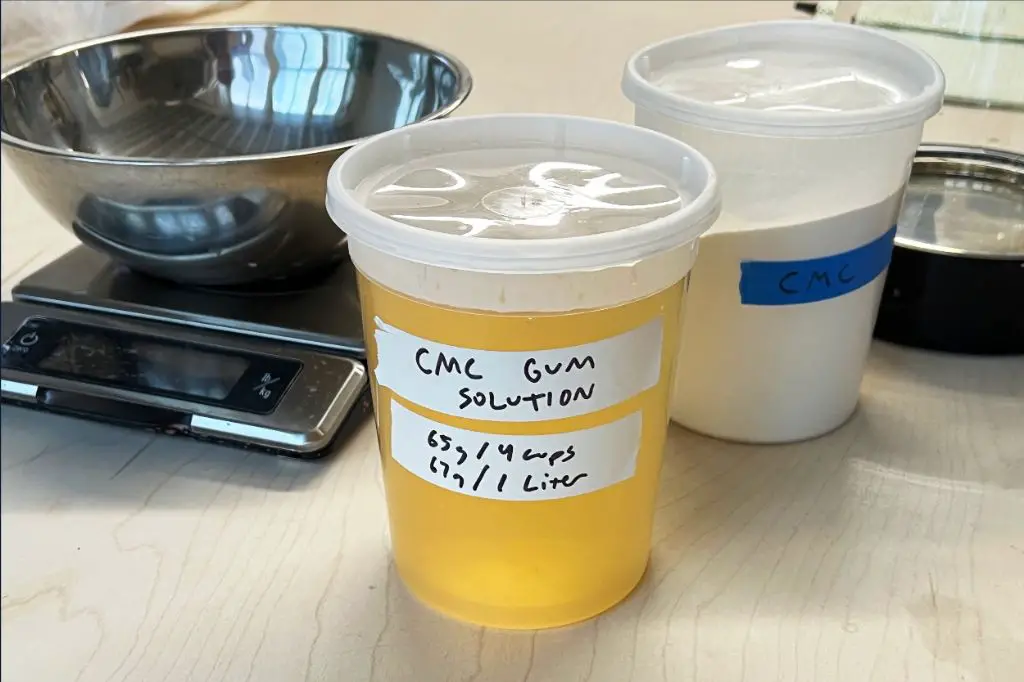Is Cmc Powder Edible?
What is CMC Powder?
CMC powder, also known as carboxymethyl cellulose or cellulose gum, is a food additive made from cellulose. Cellulose is a polysaccharide found in the cell walls of plants. To make CMC powder, the cellulose is chemically modified using chloroacetic acid or sodium monochloroacetate. This process is called carboxymethylation and it results in CMC, a water-soluble anionic polysaccharide (Carboxymethylcellulose).
CMC powder is commonly used as a thickener, stabilizer, and emulsifier in the food industry, particularly in products like ice cream, salad dressings, bakery fillings, drinks, and sauces. It helps prevent ingredients from separating, allowing food to maintain an even texture. CMC powder is also used in household products like shampoos, toothpastes, and detergents (Carboxymethyl cellulose).
CMC comes in both food-grade and industrial-grade varieties. Food-grade CMC powder is purified and meets food additive standards for safety and quality. It is derived from either wood or cotton cellulose (CMC | CarboxyMethyl Cellulose).
Is CMC Powder Edible?
CMC powder is generally recognized as safe for consumption by the FDA. It has been approved as a food additive and is commonly used as an emulsifier, thickener, and stabilizer in many foods, beverages, sauces, dressings, jellies, and more.
The safety of CMC powder is supported by several government agencies. The FDA has deemed CMC powder as GRAS (Generally Recognized As Safe). The Joint FAO/WHO Expert Committee on Food Additives has also approved it as a safe food additive. Additionally, the European Food Safety Authority has evaluated CMC and found no safety concerns when used appropriately.
While considered very safe, some people worry about potential health effects from CMC powder. However, studies show that CMC powder is not absorbed in the digestive system, so it passes through the body undigested. Any side effects are likely due to individual sensitivities or allergies, not inherent toxicity of the additive itself.
Overall, reputable health and food safety organizations widely accept CMC powder as a harmless and effective additive for modifying food texture and stability. When used according to food manufacturing guidelines, CMC powder poses very little risk of harm.
Using CMC Powder in Cooking
CMC powder is a popular ingredient used to thicken and stabilize food in cooking and baking. When added to recipes, CMC powder has unique effects on texture and consistency.
CMC powder is able to thicken liquids without causing cloudiness. It provides a smooth, glossy appearance and velvety mouthfeel. CMC can create thickened juices, sauces, glazes, and fillings with a creamy viscosity. It also acts as an emulsifier to prevent separation in salad dressings and soups.
In baking, CMC powder helps improve the stretch and strength of doughs. It stabilizes ingredients like butter and sugar to prevent them from weeping out of baked goods. CMC powder is frequently used when making rolled fondant for cake decorating, allowing the fondant to be smoothly rolled and shaped (source).
CMC can also be used as an egg white substitute in recipes. About 1/4 to 1/2 teaspoon of CMC per egg white provides similar leavening, structure, and binding effects in dishes like meringues and mousses.
Because CMC powder quickly dissolves and integrates into foods, it does not significantly alter flavor. This makes it a versatile thickening ingredient. However, excessive amounts can sometimes cause a slimy mouthfeel. Follow recipe guidelines when substituting CMC for other thickeners.
CMC Powder as a Thickener
CMC powder is commonly used as a thickener in cooking and baking. When CMC powder is mixed with water, it rapidly absorbs the water and swells up to produce a gel. This gel increases the viscosity and thickness of liquids and mixtures.
CMC powder is able to thicken liquids evenly without altering their taste or color. It is more stable under heat compared to other thickeners like flour or cornstarch. This makes it useful for thickening soups, gravies, sauces, puddings, pie fillings, and more without compromising texture or flavor.
A small amount of CMC powder can thicken a large amount of liquid. According to sources, using just half a teaspoon of CMC powder can thicken 100g of liquid [1]. The thickness depends on the ratio of CMC powder to water – less water produces a thicker gel.
Some common foods that utilize CMC powder as a thickener include: ice cream, cream cheese, yogurt, cottage cheese, jam, jelly, marinades, salad dressings, tomato sauce, lemon curd, and more. Its ability to produce thick textures makes it a versatile ingredient in many dishes.
CMC Powder Nutrition Facts
CMC powder has minimal nutritional value. It is mostly composed of soluble fiber and is not digestible by the human body. Here are some key nutrition facts about CMC powder:
- Calories: CMC powder contains practically no calories. One tablespoon of CMC powder has around 5 calories.
- Carbohydrates: CMC powder is around 95-99% carbohydrates by weight. However, the human body cannot digest or absorb these carbs.
- Fat: CMC powder contains no fat.
- Protein: CMC powder contains no protein.
- Fiber: CMC powder is primarily composed of soluble fiber. One tablespoon contains around 5 grams of dietary fiber.
- Vitamins and minerals: CMC powder has no vitamins, minerals or micronutrients.
In summary, CMC powder can be considered a “non-nutritive” food ingredient. It provides texture and thickening ability but minimal nutritional value.
Buying & Storing CMC Powder
CMC powder can easily be found at most grocery stores and online retailers. Some common places to buy CMC powder include:
- Amazon
- Walmart
- Target
- Asian grocery stores
- Restaurant supply stores
CMC powder is very affordable, typically costing $5-10 for an 8 oz package. Buying in bulk sizes can further reduce the cost per ounce.
Properly stored, CMC powder has a long shelf life. Keep it in an airtight container in a cool, dry place away from heat and moisture. Stored this way, it will keep for 1-2 years.

CMC Powder vs. Gelatin
CMC powder and gelatin have some similarities and differences in their properties and uses. Both are commonly used as thickeners and stabilizers in foods, though gelatin forms more of an elastic gel while CMC forms a smoother viscosity (https://pubmed.ncbi.nlm.nih.gov/37006365/).
Gelatin is made by boiling animal bones, skins, and connective tissues. It contains collagen, which forms protein chains that create a 3-dimensional gel structure when dissolved in hot water. CMC powder, on the other hand, is plant-based and derived from cellulose. It is more stable at higher temperatures compared to gelatin.
Some key differences in their uses:
- Gelatin is often used to make gummy candies, marshmallows, and mousses. It provides more structure and elasticity.
- CMC powder produces a smoother texture and is ideal for sauces, gravies, salad dressings, and dairy products like ice cream.
- Gelatin requires hydration in water first, while CMC powder can be sprinkled directly into recipes.
- CMC powder is preferable for vegetarian or vegan recipes as an alternative to gelatin.
In some recipes, CMC powder and gelatin can be substituted for one another in equal amounts. However, the final texture may differ slightly. Always check the recipe instructions to determine if one was chosen for a specific functional property.
Other Names for CMC Powder
CMC powder is known by several other names, including:
Alternative names:
– Sodium carboxymethyl cellulose (NaCMC)
– Cellulose gum
– Tylose powder
Regional names:
– E466 (in Europe)
– Cellulose gel
Scientific name:
The chemical name for CMC powder is sodium carboxymethyl cellulose. Its chemical formula is C8H16NaO8.
CMC stands for carboxymethyl cellulose, which refers to the manufacturing process that converts cellulose into this versatile ingredient. The “sodium” prefix indicates it is in its sodium salt form, which enables it to dissolve in water.
Safety & Side Effects
CMC powder is generally recognized as safe by the FDA. However, there are some potential side effects and risks to be aware of:
According to studies, long-term consumption of CMC powder may cause inflammation in animals. More research is needed to confirm if this occurs in humans.
CMC powder is high in fiber and may cause gas, bloating or diarrhea if consumed in large amounts, especially for those not used to high-fiber diets.
CMC powder is derived from cellulose and may cause reactions in people with tree nut allergies. People with corn allergies may also want to avoid CMC powder.
Overall, CMC powder is considered safe for most people when consumed occasionally in small amounts. Those with digestive issues or certain food allergies may want to avoid CMC powder or limit their intake.
Summary
To recap, CMC powder is edible and safe for consumption in small amounts as an additive for thickening foods. The key points covered in this article are:
- CMC stands for carboxymethyl cellulose, which is a common food additive used as a thickener and stabilizer.
- CMC powder is generally recognized as safe (GRAS) by the FDA when used according to specified limits.
- CMC powder has very minimal nutritional value and is not digested by the body.
- CMC powder can be used in recipes as a substitute for gelatin, eggs, or fat to help thicken sauces, soups, bake goods, and more.
- Some people may experience mild digestive issues if they consume large amounts of CMC powder.
- CMC powder is widely available online and in grocery stores, often sold as a gluten-free or keto-friendly thickener.
- Proper storage in an airtight container is important to prevent CMC powder from clumping.
Overall, CMC powder is a versatile and edible ingredient that can provide thickness and stability to foods when used in moderation. It does not offer much in terms of nutritional value, but is generally safe for consumption.





